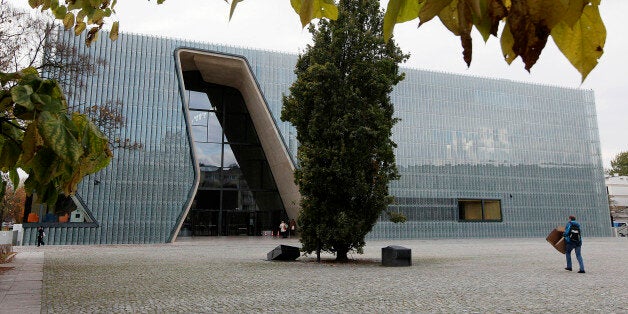
BY EMILY CADEI, OZY
Make sure to notice the smell, our guide urged us. The tour group, journalists getting a sneak peak of Warsaw’s eagerly anticipated $110-million Jewish history museum, dutifully inhaled. We were standing in what was essentially a long steel box, a replica of one of the chambers at the Nazis’ Auschwitz-Birkenau concentration camp.
“What is it supposed to smell like?” the journalists asked. Poison? Death? To me, it smelled like it looked — cold, unfeeling metal. It’s just supposed to be unpleasant, our guide explained, the scent of decay.
The Auschwitz replica was the only rusty thing at the gleaming new facility, officially the POLIN Museum of the History of Polish Jews, which has been 20 years in the making. This centerpiece exhibition is set to open to the public today with a grand ceremony featuring dignitaries from around the world. It comes at a touchy time in Europe, where acts of anti-Semitism are again on the rise.
But though it’s dedicated to the memories of the dead — generations and generations of Europe’s largest Jewish community — and some particularly grim chapters in human history, it pulsates with life.
The 138,000-square-foot building, an outsized geometric glass bauble designed by Finnish architects, is set in the heart of what was once Warsaw’s bustling Jewish quarter that became the Warsaw ghetto under German occupation during World War II. At the time, 350,000 Jews — a third of Warsaw’s population — were packed into the area, along with another 100,000 transferred from elsewhere. The Germans razed the ghetto after its residents staged a last-gasp uprising in 1943. Today it’s a quiet residential area of low-rise, Soviet-style apartment blocks. Only 10,000 to 20,000 Jews live in Poland today.
We’re all familiar with what happened in the interim — the Nazi’s systematic killing of European Jews in concentration camps, the most lethal of which were in Poland. The core exhibit at the museum, A Thousand-Year History of Polish Jews, looks unflinchingly at the Holocaust and the indifference of most Poles. But it doesn’t dwell on the atrocity or other periods of particularly vicious anti-Semitism, like the pogroms at the turn of the 20th century.
Instead it’s a full immersion into the lives of Poland’s Jews from the Middle Ages through today, in all their joy and horror, everyday rituals and flashes of heroism. The exhibit is a feast for the senses — not just with splashy visuals, but also elements to touch, hear and, yes, smell. Stand in a “forest” with screens of waving branches while the birds chirp — Jewish legend.
For Poland, finishing the museum is part of a long journey to honor history that was mostly buried during World War II and decades of communist rule afterward. The Polish government footed the bill for the $60-million building, but the exhibit and museum activities were funded by the Association of the Jewish Historical Institute of Poland, made up of Poland’s Jewish community and its descendants. Donations also came from the United States, including from Jewish philanthropies like the California-based Taube Foundation. Scholars from New York University and Brandeis University headed up the curation of the historic materials.
But for all its international contributors, the museum is proudly Polish — and the duality that comes from being both a onetime Paradisus ludaeorum, or Jewish heaven, as well as the heart of the Holocaust is made plain. As former Polish Foreign Minister Daniel Rotfield observed in a statement marking the museum’s opening, “There is no history of Jews in Europe without Poland. Just as there is no history of Poland without the Jewish community that lived in this country for centuries.”